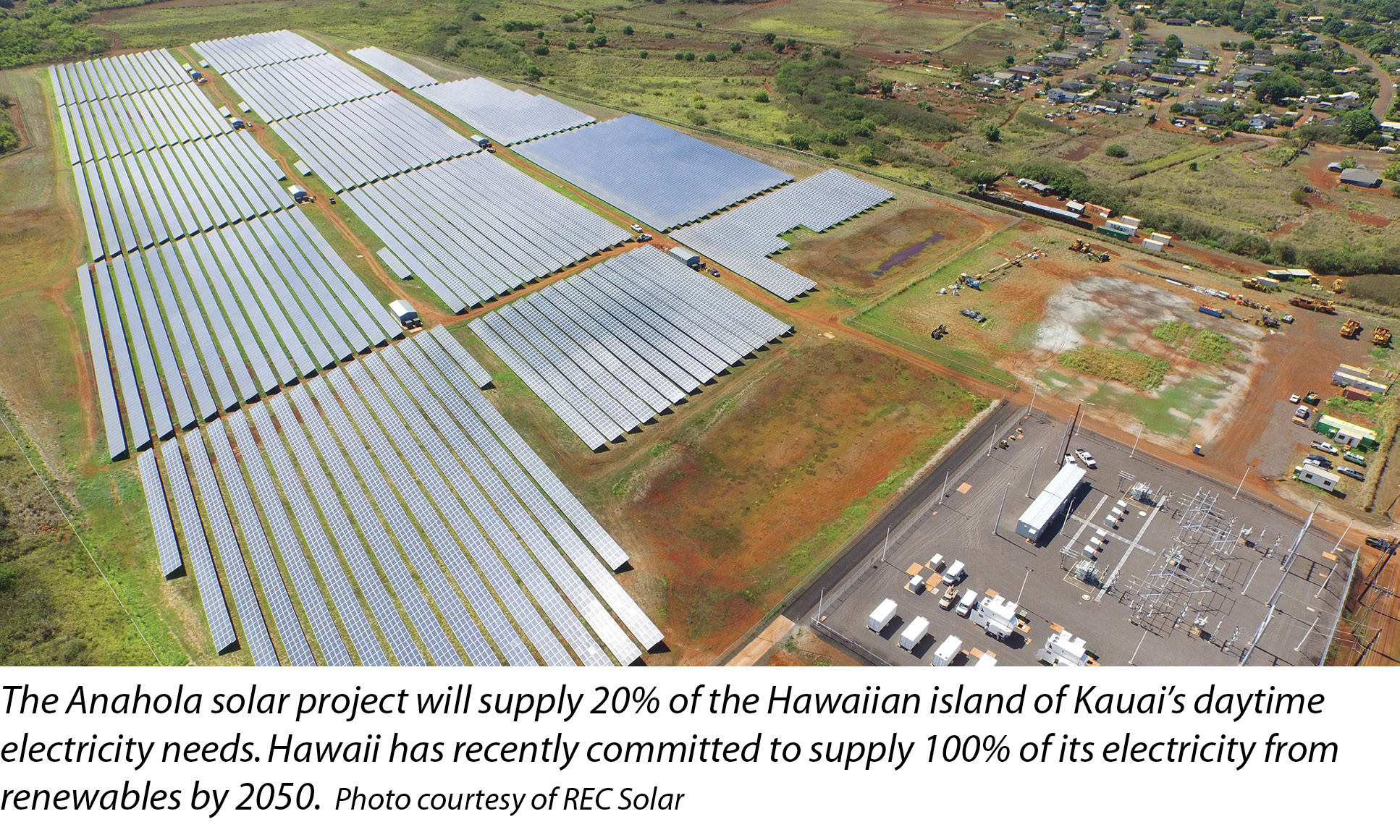

301 Moved Permanently
Nature’s method of harnessing the sun for power through photosynthesis is only 1% efficient at converting solar energy into biomass. And yet, the process harnesses enough energy to provide the basis for life on Earth. If humanity could harness the energy from a small proportion of the sunlight hitting the Earth, that energy could provide for all of our current energy needs.
Due to its abundance as an energy resource and as part of efforts to reduce carbon emissions, the use of solar power has been promoted globally - primarily through solar thermal and solar photovoltaic technology. There were initial moves toward the greater use of solar with the oil crisis of the 1970s, but the falling price of oil, high prices of solar technologies and variable government commitments to promoting its use have meant that large-scale application of solar technologies has only seriously come about over the last two decades.
The fortunes of the solar industry vary in different parts of the world due to the diverse nature of its economies, political institutions and scales of infrastructure. For example, off-grid or microgrid solar PV applications are the norm in rural areas of many developing nations that have little or no electricity grid infrastructure. Developing economies, such as China and India, with national electricity networks have large-scale, grid-connected solar PV and concentrating solar power (CSP) plants alongside small-scale applications. However, these larger players also have quite different economic models and support regimes for solar technologies compared with developed countries, such as the U.S. and those of Europe.
The development of the solar industries in Europe and North America provides helpful insight into future opportunities for the solar industry and the world as a whole. There have been moves to increase the proportion of power derived from renewables in North America and Europe in order to meet climate change and energy security concerns. Various support mechanisms have been put in place in order to encourage the adoption of these schemes and enable them to compete with established energy generation technologies. In the case of solar, this is best seen in the U.S. and central and southern European nations.
Lessons from Europe
Governments have provided support for the solar industry via feed-in tariff contracts and capital grants that provide long-term financial incentives to encourage investment. These measures have meant that solar installations - largely for residential or small industrial-scale installations of solar PV panels - have been developed at a rapid rate in many countries in Europe. In some countries, such as Spain, this has been so successful that solar power now accounts for a substantial proportion of total electricity generation.

In some instances, there have been shortfalls with the design of these programs. The initial success of these schemes has, in many instances, led to much greater numbers of applications for installations - and, subsequently, penetration rates - than were predicted. This effect can lead to boom-and-bust dynamics, which are unstable. Thus, unrealistic predictions of future supply can lead to over-investment on the part of companies and, ultimately, overcapacity in a market.
Moreover, governments often change the regulatory environment in response to this initial success, scaling back or removing support mechanisms and further exacerbating the boom-and-bust effect, thus leading to the insolvency of many suppliers and installers. This has been the case in a number of European countries, such as Spain and Greece, where governments facing financial difficulties have rapidly reduced the amounts being paid out in incentive schemes or have halted them abruptly in the face of multiple competing economic priorities. Many of the previously successful subsidy regimes are now under pressure, and rates of installations of solar technologies have decreased precipitously. Private-sector investment in solar in these countries has also generally declined due to the perceived reduction in financial stability and long-term support for the sector.
Even if a country is not facing immediate financial difficulties, changes in government policy can still have a substantial effect. In the U.K., levels of subsidy for solar power have been reduced by 87% in order to meet a government-imposed cap on spending for renewable projects.
In addition to regulatory and government support factors, other issues can arise that affect a country’s solar sector. Because of the variable output of electricity from solar PV installations, there is a limit on the proportion of power that can be generated using the technology on a conventional power grid system. Germany is now facing issues with balancing its national grid due to its success in increasing the proportion of electricity generated from renewable sources. This is an infrastructure planning issue that, in large part, can be mitigated with sufficient energy storage capacity and interconnectors with other nations. The timescales and financial considerations by which such solutions can be implemented do, however, place limitations on the amount of solar PV installations that can be installed on a grid.
These issues affect solar thermal technologies to a lesser degree than they affect solar PV installations because they can provide 24-hour electricity with the appropriate storage technologies. CSP plants are arguably more relevant in the U.S. than in large parts of Europe because they are the most commercially viable at relatively southerly latitudes with high levels of solar irradiation. In Europe, CSP has mainly been relegated to Spain, which had a tax incentive scheme to support its construction. However, the funding for further projects has now been withdrawn because of the country’s financial situation.
Solar power in the U.S.
There is considerable support for solar PV installations in a number of U.S. states, with New York and California among the leaders. Many states provide strong financial support for PV installations, and some seem to be trying to outdo each other with pledges to source one-third, one-half and even all of their power from renewable sources, as Hawaii has done.
The support available for solar technologies in many parts of the U.S. is currently very robust, with strong incentives for their installation. At the same time, the experiences of the solar industry in Europe show that it pays to watch the regulatory landscape. In the current investment climate, large-scale projects - which rely on large-scale infrastructure and long-term guarantees of government support - have the greatest risk of disruption. As has been seen in a number of European countries, if a government is faced with financial difficulties and must choose between multiple competing priorities, support for solar installation schemes may be reduced or withdrawn.
Other factors, such as local planning regulations, environmental considerations and infrastructure capacity for new projects, also need to be taken into account.
The issues that an individual project will face will be contextual and technology dependent: Small-scale solar thermal water heating installations are low cost, easy to install and effective in a wide variety of locations. Solar PV installations are also very versatile and can be used in a huge range of applications. This, combined with falling prices for solar PV panels, means that a diverse and robust market for them is likely to continue, even if government support is withdrawn at the federal or state level.
There has been a history of support in some states for CSP plants. A number of large-scale installations have been built in the U.S. Southwest and California that produce substantial amounts of power. Such plants have the potential to provide a significant percentage of electricity production on a regional level, though they have been subject to criticism over environmental and cost factors. One particularly well-known plant, the Ivanpah project in California, has received a great deal of criticism due to environmental concerns about the siting of the installation.
At the same time, the falling cost of PV technologies has put the brakes on plans for future CSP plants.
A number of projects initially designed as CSP plants have been converted to solar PV technology due to the falling cost of panels. As a result, the domestic market for solar concentrating plants is currently stagnant - although, there may be great potential for U.S. companies with construction expertise to build projects overseas. For example, BrightSource Energy, the company that constructed Ivanpah, is now moving into the international market for future projects.
Studying the ways in which developed countries manage the development and deployment of solar power while navigating its technical, political and economic pitfalls will serve as a lesson learned as the rest of the world works to harness the sun. R
Solar In Europe And The U.S.
Two Steps Forward, One Step Back: Solar Progress And Pitfalls In Europe And The U.S.
By Gordon Moran
Lessons learned from solar advancement in developed countries serve as examples for each other and the rest of the world.
si body si body i si body bi si body b
si depbio
- si bullets
si sh
si subhead
pullquote
si first graph
si sh no rule
si last graph